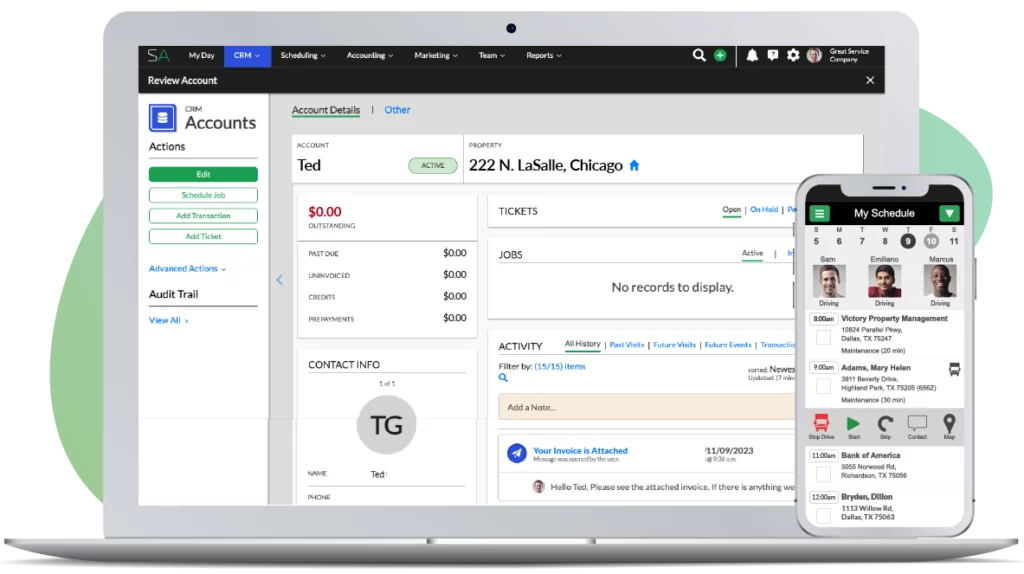Jonathan:
Hey. So, this isn’t a question. This month, this is October, this month we are doing an academy, Service AutoPilot Academy, a session on finance. It’s a multi-multi hour workshop. It requires you get or ideally pull together your P&L statement, your balance sheet. You pull your receivables. If you’re accrual-based, you pull your payables. You do all these different things. You figure out your total man-hours sold for the year, at least from January 1 through the end of September. And we’re going to go through a whole workshop, and a great friend of mine by the name of Jason Cupp out of Kansas City, Missouri is basically doing, he’s doing the training, he’s doing the session. It’s incredibly valuable.
So, I gave you a little backstory to tell you where this is coming from and why I’m talking about this. So, I have been very fortunate now in that I’ve built a number of companies. You probably know about Service Autopilot, you know about City Turf, but I’ve actually had some other companies as well. Another one of the companies has been very successful that I was a partner in.
So when you go to an event, a party, or you meet somebody, or you go to a business group or networking group, depending upon what kind of group it is, people say, “Hey, what do you do?” And you answer that question. Some people say, “Oh, how many, how big are you, how much money do you do, like gross revenue?” And gross revenue is always that metric that everybody wants to talk about. Gross revenue is like that, I’ve heard it called The Vanity Metric. It’s the one that makes you look cool, but it actually doesn’t tell much. So, you could say, “I’m a 10 million dollar company.” That’s cool. That’s a huge accomplishment. Like .0004 of companies ever get there. Whatever the math is, it’s a very small number.
So, yeah, that’s a huge accomplishment. But, you could be a 10 million dollar company, and you as the owner make a hundred and whatever, it’s called a hundred thousand dollars a year, and you get a fifty thousand dollar distribution. So, out of a ten million dollar company, you’re making a hundred and fifty grand. A hundred and fifty grand is not a bad amount of money, it’s not exciting, but it’s, I mean, for especially after spending whatever amount of time it took and risk it took to get to ten million dollars, but it’s a very small amount of money on a ten million dollars business. Like ridiculously small. So, you might look like oh, you’re a genius. You got to ten million dollars, but you’re making a hundred and fifty grand a year.
And there’s a whole bunch of people that have built million dollar a year companies, ten times smaller, making 150,000 dollars a year. They’re running well-run businesses. And some make even more than that. On very well-run businesses, usually businesses that are not growing too crazy fast, because if you grow really fast it costs a lot of money and therefore they don’t make the bigger incomes.
So, here’s the point. The big revenue number and profit across a lot of companies that I’ve seen are not aligned. If you’re doing ten million dollars, that does not tell me that you’re making a million dollars a year or two million dollars a year in income. It doesn’t tell me that at all. If you’re making five million dollars a year, it doesn’t tell me if you’re making a hundred grand or five hundred grand or a million dollars a year in income. None of those things. I can’t predict any of that knowing your gross revenue. Yet, that’s the number everyone talks about.
So if you extrapolate down from that, there’s a lot of individuals running around saying hey, in landscape or whatever, I make 80 grand on a project. That doesn’t mean you actually made any money. It doesn’t mean that it netted to your organization 8,000 or 16,000 in profit. It might have resulted in 2,000 dollars in profit yet it took you three months to do that job. Yet it was the bottleneck inside your organization that consumed you as the owner to manage the 80,000 or 100,000 dollar project and kept you from growing the organization, from marketing and selling and doing all the other things you had to do.
There’s no correlation between big project revenue, big gross revenue, and margin. And so the reason I talk about this is the thing you want to focus on inside your business. Yes, you want to grow a bigger business, yes, you want to do bigger projects. Yes, you want bigger contracts, but from early on in the business, the thing you want to focus on is job-costing and it’s the margin on your work. And it’s the percentage of labor as related to the total revenue of the organization, as related to the total revenue of the job. And I’ve said this before many times on these videos, if you simply watch for a maintenance-based company, if you simply watch labor. So forget project work for the moment. I got to come back to that, I had a thought there. From a maintenance standpoint, if you simply watch labor and you say I am making this amount of money per man hour on every job and you compare what you bidded for. You bidded for 80 hours, what were the actual hours.
So budgeted hours or estimated hour were 80. Did we do it in 60, did we do it in 80, did we do it in 100? You watch that number, estimated versus actual, and then the next number you watch is what are we making per man-hour on the job? What are we making per man-hour when we pull up in front of the job, we perform the work, and we get back in the truck and leave. During that period of time, how much are we making per man-hour which is a simple equation. It’s the total hours, total time on the job divided by the number of individuals that work that job, that gives you … Well, and then you take into account what you charge for the job. That gives you … I did a terrible job explaining what that calculation is.
But those numbers right there, they give you your per man-hour rate on an hourly basis. And that becomes a benchmark. Are you making 40 man-hour, 30 man-hour, 20 man-hour, 50 man-hour? You watch that number on every job and you make sure that every job comes in based on the estimated amount of time, so actual time versus estimated. And when you’re wrong, you learn from it and adjust your future estimating. And when you watch every job and you say, “How much are we making per man hour.” If I want to make 45 a man-hour, what are the jobs that are not making 45 a man-hour?
I go fix those, I get the price up or I cancel those clients and I take care of that. And I adjust my estimating accordingly so I’m bidding them properly to make that hourly rate. Then your margin is going to work out. Then when you build a one million, five million, 10 million dollar business, or maybe you don’t care about any of that, you build a 500,000 dollar business, you’re actually going to make nice money.
But the majority don’t do that. And I have fallen into that trap as well because I was running so fast to get to a goal of I wanted 1,000 clients. That was the only thing that mattered. I’ve told this story before. Then what happens is, you block out everything else. It’s estimate, sell, estimate, sell, every day, day in and day out. And then you miss the job costing and the watching the margins and all the other stuff that leads to profitable work. And then when you ignore that stuff, you’re selling work that’s costing you money or you’re selling your work that’s barely making you any money and then you have no money to grow the organization.
Watching the margin is where you get all the money that you need to go hire better people so you don’t have to do all the work so you have more money to do more marketing. And that’s the takeaway of everything I’m saying here. Don’t get to enamored by the individual that’s running the five million dollar business or 10 million dollar business. Be more enamored by the individual that’s running an incredibly efficient business, whether that’s 500,000 or million or 10 million. That individual is very interesting. And for most of us entrepreneurs, we move very fast and we care about the gross revenue, and we care about selling the next thing and the next thing.
And generally, we are not as excited about or wired to pay attention to the operational side, the number side of our businesses and that’s where we get hurt. And that’s why when we sell our businesses for pennies on the dollar to a professional management company, they take our thing and they turn it into a high-profit machine because they apply professional management to the business that watches those numbers, that manages it tightly from an operational standpoint and they will, and they make all the money.
And so think about those things. And if you have any questions, you can post them below and I’ll take another stab at answering this. But I think it’s one of the most important topics inside our industry. It’s the thing that most of us who came into the industry didn’t know and we had no background in it. And it takes us five, eight, 10 years or so much pain in our business and our life that we finally start to learn this stuff. The earlier you learn it, the faster you go. And that was true for me. I didn’t naturally know all this stuff either. I had to learn it and I had to learn it because of pain. So hope that helps. Ask questions if it doesn’t. Thanks a lot.
Podcast: Play in new window | Download
Subscribe: RSS



